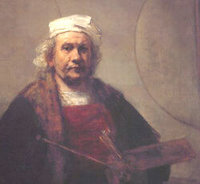|
|
Rembrandt Harmenszoon van Rijn (July 15, 1606 - October 4, 1669) is generally considered one of the greatest painters in European art history, and the most important United Provinces (Netherlands) painter of the seventeenth century.
Self-portrait by Rembrandt (1661) Rembrandt was also a proficient engraver and made many drawings. His contributions to art came in a period that historians call the Dutch Golden Age (roughly equivalent to the 17th century), in which Dutch culture, science, commerce, world power and political influence reached their pinnacles. Works In all, Rembrandt produced around 600 paintings, 300 etchings, and 2,000 drawings. He was a prolific painter of self-portraits, producing almost a hundred of them (including some 20 etchings) throughout his long career. Together they give us a remarkably clear picture of the man, his looks, and — more importantly — his emotions, as misfortune and sorrow etched wrinkles in his face. Among the prominent characteristics of his work are his use of chiaroscuro, often using stark contrasts, thus drawing the viewer into the painting; his dramatic and lively scenes, devoid of any rigid formality that contemporary artists often displayed; and his ostensibly deeply felt compassion for mankind, irrespective of wealth and age. His immediate family — his first wife Saskia, his son Titus, and his second wife Hendrickje — often figured prominently in his paintings, many of which had mythical, biblical, or historical themes. Life Rembrandt was born on July 15, 1606, in Leiden, the Netherlands, although the evidence for his birthdate is sketchy - the evidence that exists suggest he was born in 1607. Conflicting sources state that his family either had 7, 9, or 10 children. His father was a miller, his mother was a baker's daughter. He spent his youth and most of his early years as a painter there. He attended Latin school and studied less than a year at the University of Leiden. Sometime after this, he studied with an influential artist by the name of Latsman. In 1621, he decided to dedicate himself fully to painting and took lessons from Leiden artist Jacob van Swanenburgh. After a brief but important apprenticeship in Amsterdam, Rembrandt opened a studio in Leiden, which he shared with friend and colleague Jan Lievens. In 1627, Rembrandt began to accept students. By 1631, Rembrandt had established such a sound reputation that he received several assignments for portraits from Amsterdam. As a result, he moved to that city and into the house of his art dealer, Hendrick van Uylenburgh. This move eventually led, in 1634, to the marriage of Rembrandt and Hendrick's wealthy niece, Saskia van Uylenburg. A daughter of a patrician, she introduced him to higher social circles, which increased his fame. In 1639, Rembrandt and Saskia moved to a prominent house in the Jodenbreestraat in the Jewish quarter, which later became the Rembrandt House Museum. Three of their children died shortly after birth. Their fourth child, a son, Titus, was born in 1641 and survived into adulthood. Saskia died in 1642 soon after Titus' birth, from tuberculosis. In 1645, Hendrickje Stoffels, who had initially been Rembrandt's maidservant, moved in with him. In 1654 they had a daughter, Cornelia, bringing them an official reproach from the church for "living in sin". Rembrandt lived beyond his means, buying many art pieces, costumes (often used in his paintings), and rarities, which caused his bankruptcy in 1656. He had to sell his house and move to a more modest accommodation on the Rozengracht. Here, Hendrickje and Titus started an art shop to make ends meet. Rembrandt's fame waned in these years, only to be restored later. Rembrandt outlived Hendrickje and Titus. In the end, only his daughter Cornelia was at his side. He died October 4, 1669, in Amsterdam in poverty and was buried in an unknown grave in the Westerkerk. Periods, themes, and styles It was during Rembrandt's Leiden period (1625-1631) that Lastman's influence was most prominent. Paintings were rather small, but rich in details (for example, in costumes and jewelry). Themes were mostly religious and allegoric. During his early years in Amsterdam (1632-1636), Rembrandt used large canvases and strong tones and depicted dramatic scenes. Rembrandt painted many portraits in this period. Other paintings had biblical and mythological scenes. In the late 1630s, Rembrandt painted many landscapes and produced etchings about nature. In this period, his landscapes were tormented by nature, showing trees taken down by a storm or ominous skies with dark clouds. Starting in about 1640, his work became more sober, reflecting the family tragedies that he had suffered. Exuberance was replaced by deeply felt inner emotions. Biblical scenes were now derived more often from the New Testament instead of the Old Testament, as had been the case before. Paintings became smaller again. An exception is the huge painting The Night Watch, his largest, which was as worldly and spirited as any previous painting. Landscapes were more often etched than painted. The dark forces of nature made way for quiet Dutch rural scenes. In the 1650s, Rembrandt's style changed again. Paintings increased in size. Colours became richer, brush strokes stronger. With these changes, Rembrandt distanced himself from earlier work and current fashion, which increasingly inclined towards fine, detailed works. Over the years, biblical themes were still depicted often, but emphasis shifted from dramatic group scenes to intimate portrait-like figures. In his last years, Rembrandt painted some of his finest self-portraits, showing a face on which grief and sorrow had left their marks. Museum collections In the Netherlands, the most notable collection of Rembrandt's work is at Amsterdam's Rijksmuseum, including De Nachtwacht (The Night Watch) and De Joodse bruid (The Jewish Bride). Many of his self-portraits are held in The Hague's Mauritshuis. His home, preserved as the Rembrandt House Museum in Amsterdam, houses many examples of his engravings. Prominent collections in other countries can be found in ) Artcyclopedia (http://artcyclopedia.com/artists/rembrandt_van_rijn.html) has an extensive list of museums that show Rembrandt's work. Rembrandt Research Project ( Retrieved from "http://en.wikipedia.org/"
 |
|
|||||||||||||||||
